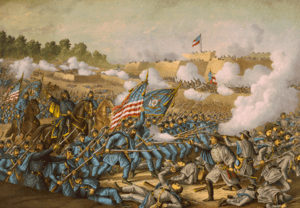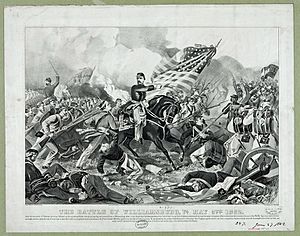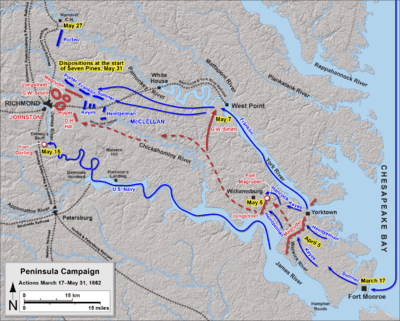Battle of Williamsburg facts for kids
Quick facts for kids Battle of Williamsburg(Battle of Fort Magruder) |
|||||||
|---|---|---|---|---|---|---|---|
| Part of the American Civil War | |||||||
 Battle of Williamsburg, by Kurz and Allison, 1862 |
|||||||
|
|||||||
| Belligerents | |||||||
| Commanders and leaders | |||||||
| George B. McClellan | Joseph E. Johnston James Longstreet |
||||||
| Units involved | |||||||
| Army of the Potomac | Army of Northern Virginia | ||||||
| Strength | |||||||
| 40,768 | 31,823 | ||||||
| Casualties and losses | |||||||
| 2,283 | 1,682 | ||||||
The Battle of Williamsburg, also known as the Battle of Fort Magruder, was an important fight during the American Civil War. It happened on May 5, 1862, near Williamsburg, Virginia. This battle was part of a larger plan called the Peninsula Campaign.
In this battle, almost 41,000 Union soldiers fought against about 32,000 Confederate soldiers. It was the first major battle of the Peninsula Campaign. The fighting ended without a clear winner, but the Confederate army continued to move away.
After the Confederates left Yorktown, Union soldiers, led by Joseph Hooker, caught up with them near Williamsburg. Hooker's troops attacked Fort Magruder, a strong dirt fort, but they were pushed back. Confederate forces, led by James Longstreet, then tried to push back the Union soldiers even more.
However, more Union troops arrived, led by Philip Kearny, which helped to steady their lines. Another Union general, Winfield Scott Hancock, then moved his soldiers to attack the Confederate side. The Confederates tried to fight back but were not successful. Even though Hancock had a good win in his area, the Union army didn't fully use this advantage. The Confederate army kept moving towards Richmond, Virginia, during the night.
Contents
Why the Battle Happened
Confederate Retreat from Yorktown
Confederate General Joseph E. Johnston surprised the Union army by pulling his troops away from Yorktown on the night of May 3. Union General George B. McClellan was not ready for this sudden move.
On May 4, McClellan sent his cavalry (soldiers on horseback) to chase Johnston's army. He also sent about half of his main army, the Army of the Potomac, to follow them. McClellan also tried to send some troops by ship up the York River. He hoped they could land and cut off Johnston's escape route.
However, it took two days to get the soldiers and their gear onto the ships. Because of this delay, these troops did not join the battle on May 5. They landed later and fought in the Battle of Eltham's Landing on May 7.
Setting Up a Stand at Fort Magruder
By May 5, Johnston's army was moving slowly because the roads were very muddy. Union cavalry was already fighting with Confederate cavalry, which was protecting Johnston's main army. To give his main army more time to get away, Johnston decided to leave some of his soldiers behind.
These soldiers were ordered to make a stand at Fort Magruder. This was a large dirt fort built earlier by General John B. Magruder. It was located right on the main road from Yorktown to Williamsburg.
Who Fought?
| Opposing Commanders at Williamsburg |
|---|
|
Union Forces
The Union army was led by Major General George B. McClellan. The main Union troops involved were from the Army of the Potomac.
Confederate Forces
The Confederate army was led by General Joseph E. Johnston. The main Confederate troops involved were from the Army of Northern Virginia.
What Happened During the Battle?
Hooker's Attack and Confederate Counterattacks
The first Union soldiers to arrive were from General Joseph Hooker's division. They attacked Fort Magruder and the nearby trenches. However, the Confederates pushed them back.
Confederate counterattacks, led by General James Longstreet, almost defeated Hooker's division. Hooker's men had been fighting alone since early morning. Hooker had expected another Union division to help him, but they were stopped by General Edwin Vose Sumner more than a mile away. Sumner was worried the Confederates might attack him instead.
Longstreet's soldiers did leave their forts, but they attacked Hooker's men. The Confederates put a lot of pressure on Hooker's line. Union army bands played music like Yankee Doodle to encourage the retreating soldiers to stop and fight again. This helped them until General Philip Kearny's division arrived around 2:30 p.m. Kearny bravely rode his horse in front of his soldiers, urging them forward. The Confederates were pushed back into the woods and their defenses. Fierce fighting continued there until late afternoon.
Hancock's "Superb" Attack
While Hooker was fighting at Fort Magruder, General Winfield Scott Hancock's brigade moved to the right side of the Union line. Around noon, they started firing cannons at Longstreet's left side.
Confederate General Daniel Harvey Hill sent a brigade under General Jubal Early to stop Hancock. Early led two of his regiments through the woods without checking the area first. They ended up right in front of Hancock's cannons, which were in two abandoned forts. Early personally led an attack and was wounded.
Hancock had been told to pull his troops back, but he used the Confederate attack as a reason to stay. When the Confederates charged, Hill realized Hancock had many more soldiers and cannons. He tried to stop the attack, but it was too late. The Confederates suffered heavy losses, while Union losses were much smaller. After the battle, Hancock's counterattack was praised as a brave bayonet charge. General McClellan called his performance "superb," earning Hancock the nickname "Hancock the Superb."
Reinforcements for Hooker
Around 2:00 p.m., General John J. Peck's brigade arrived to help Hooker's line. Hooker's troops had been pushed back into the woods near the Confederate forts. Their spirits were low because they had lost some of their cannons. Peck's arrival and his brigade's recovery of a lost cannon battery came at a very important moment. It helped prevent Hooker's division from completely retreating.
What Was the Result?
The newspapers in the North said the battle was a victory for the Union army. General McClellan even called it a "brilliant victory" against a larger force. However, the Confederates saw the battle as a success because it helped them delay the Union army. This delay allowed the main Confederate army to continue its retreat towards Richmond.
The Confederates had about 1,682 soldiers killed, wounded, or missing. The Union army had more losses, with about 2,283 soldiers killed, wounded, or missing.
Battlefield Preservation
Today, much of the original battlefield has been built over. However, groups like the American Battlefield Trust have worked to save parts of it. They and their partners have protected more than 98 acres (about 0.4 square kilometers) of the battlefield. This includes a 29-acre piece of land bought in December 2020.
See also
 In Spanish: Batalla de Williamsburg para niños
In Spanish: Batalla de Williamsburg para niños





